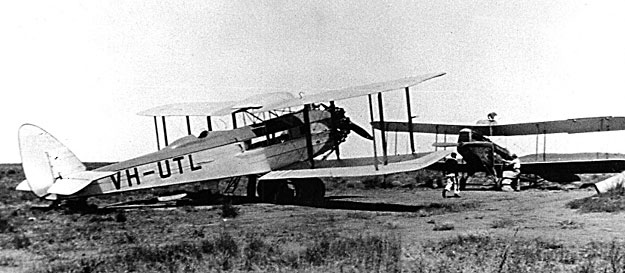The
De Havilland DH61 Giant Moth in Western Australia
by
Ian Howell
In
1931 increasing traffic on the North West Service caused West Australian Airways
(WAA) to look around for an aircraft with more capacity than their existing, four
passenger DH50. The De Havilland DH61 Giant Moth fitted the bill with its enclosed,
eight-passenger cabin and a 500 hp Armstrong Siddeley Jaguar engine.
The Giant Moth could also be fitted with the 450 hp Bristol Jupiter engine which was already being used in the DH66 Hercules fleet on WAA's Perth-Adelaide Air Mail service. This fitted in very nicely, helped minimise the carriage of spares and simplified engine maintenance and service procedures with an ability to interchange engines between various aircraft. Initially the more powerful 500 hp geared Jupiter XI was supposed to be available, but these were all needed for military contracts and so the 450 hp direct drive, ungeared Jupiter VI was supplied.
Ten Giant Moths were built by De Havilland at Stag Lane. The type was designed by the famous Arthur Hagg in response to an Australian requirement for a DH50J replacement. The pilot sat in an open cockpit, aft of the passenger cabin. The cockpit was offset to the port side so the pilot could see what he was doing. Passenger accommodation could be increased to 8 if baggage was reduced to 600 pounds. However, with the long sectors of the North West run large fuel loads would have taken part of the normal payload.
Test flying was done by Hubert Broad in January 1928 before shipment to Australia of the first Giant Moth, which had been registered in England G-EBTL. The aircraft arrived and was erected by De Havilland at Essendon. It was then delivered in March 1928 as G-AUTL Old Gold to Horrie Miller of Macrobertson Miller Aviation Co (MMA) at Parafield, South Australia. The aircraft was re-registered as VH-UTL in 1930.
In April 1931, Major Norman Brearley was able to buy the DH61 VH-UTL Old Gold and it would continue on in service with West Australian Airways until mid-1935.

DH61 Giant Moth VH-UTL with West Australian Airways' DH50
Later,
West Australian Airways was also able to buy another Giant Moth, VH-UQJ.
VH-UQJ,
was originally G-AAAN Geraldine, the fifth production aircraft, of Associated
Newspapers with a 500 hp geared Jupiter engine. This aircraft was employed in
Britain in October 1928 as a mobile newsroom. It carried a motorbike for its reporter
and photographer to go anywhere to get a story, and contained its own darkroom
for processing negatives. It travelled all over the British Isles and Europe.
Sold to National Flying Services in February 1930 and renamed Leone, it
was used for taxi work.
Early in 1932 G-AAAN was sold to West Australian Airways for the North West Air Mail Service, becoming VH-UTL. Together these two DH61 Giant Moths were operated in Western Australia until 1935.

DH61 Giant Moth VH-UQJ operated in Western Australia for four years with West Australian Airways on the North West Air Mail route.
WAA's North West route ran as follows: Perth-Geraldton-Carnarvon-Onslow-Roebourne-Port Hedland-Broome-Derby-Wyndham. The two Giant Moths were probably used on the Perth to Carnarvon sector of the North West route, which would have had the heaviest passenger traffic.
West Australian Airways lost the North West Air Mail service contract in 1934 to MMA. Then, in the same year, Qantas was awarded the Empire Air Mail contract to fly air mail from Brisbane through Darwin to Singapore. This led to a dramatic reduction to loads on West Australian Airways' Perth-Adelaide route, since the air mail bound for England had previously left Australia on the Mail Steamer from Fremantle to Karachi.
This dramatic revenue reduction, in conjunction with the economic depression, forced Brearley to sell some of the WAA aircraft assets. As a result the Giant Moths were disposed of in early 1935.
VH-UQJ
and VH-UTL were both sold to Guinea Airways for service in New Guinea.
New
Guinea had virtually no roads and very difficult terrain to cross. As the gold
mines developed in the 1930s, demand for air cargo services from the coast to
the New Guinea Bulolo goldfields could not be satisfied and the airline business
was booming. Guinea Airways had been handling some of the heaviest air cargo loads
in the world, flying in massive mine engineering equipment. Unfortunately the
West Australian Giant Moths did not last long in New Guinea: VH-UQJ crashed in
Wau in August 1935 and VH-UTL was withdrawn from use in September 1936.
By
1934, the age of the large passenger airliner with only a single engine had passed.
Airlines realised that to build traffic, safety had to be improved. MMA won
the North West Air Mail contract in 1934 from West Australian Airways with a bid
to fly twin-engined DH84 Dragons.
(Photos:
Ted Fletcher)
References: De Havilland Aircraft Since 1909, A J Jackson.
Back
to the main Western Australia index
Back to the main Items of General Interest index
If
this page appears without a menu bar at top and left, click
here